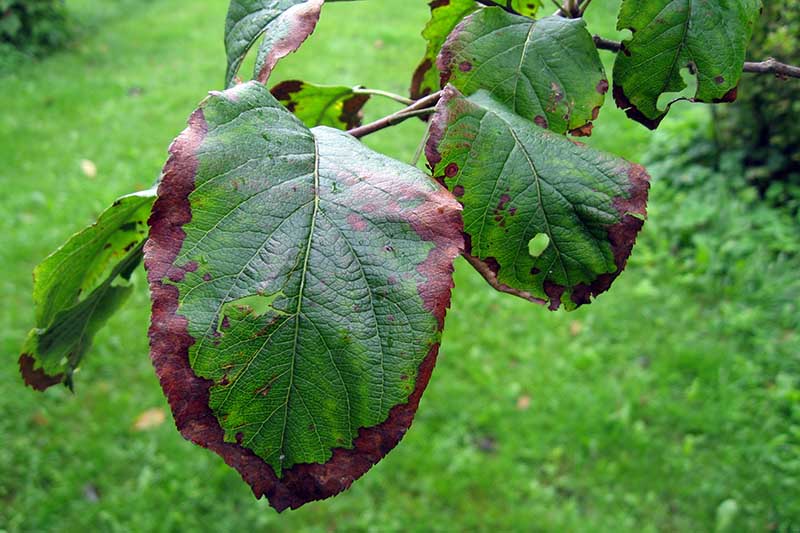
Prevention & Treatment: Remove all infection sources, such as blighted twigs and cankers, before growth starts in the spring.

University – USDA Cooperative Extension Slide Series, ww. During wet weather, a milky-like, sticky liquid that contains bacteria can be seen on the stems and branches. Dead leaves often remain attached to the branch. The tips of infected young twigs wilt and die, forming a shepherd’s crook as the disease moves down the branch. Blossoms and young leafy twigs show the first symptoms, appearing wilted or shriveled and turning brown to black. The disease develops rapidly in early spring during rainy weather when temperatures are above 60 ☏ and the tree is in bloom. Fire Blightįire blight is a devastating disease caused by the bacterium Erwinia amylovora and is very difficult to control. Apply all chemicals according to directions on the label. See Table 1 for examples of brands and specific fungicide products. The fungicide for use on crabapple trees is mancozeb (do not spray after bloom) or myclobutanil. For apples select one of the following: mancozeb (do not apply after bloom), myclobutanil or sulfur. If disease is severe enough to warrant chemical control, select from the chemicals below. If possible, remove Eastern red cedars from the area or prune out galls on nearby cedars. Prevention & Treatment: Plant resistant varieties.
#Fire blight of apple full
Joseph O’Brien, USDA Forest Service, In the spring following a rain, the galls produce large, orange, gelatin-like tendrils, full of spores, which can blow up to a ½ mile to infect nearby apple or crabapple trees. Apply all pesticides according to directions on the label.Ĭedar apple rust gall on cedar in spring, after rain. Apple varieties resistant to apple scab are ‘Goldrush’, ‘Enterprise’, ‘Pristine’, ‘Gala Supreme’, ‘Liberty’, ‘Freedom’, and ‘Jonafree’.įungicides for crabapple trees are captan, mancozeb or thiophanate-methyl. If disease is severe enough to warrant chemical control, choose one of the following fungicides for use on apple trees: captan, mancozeb, thiophanate-methyl or sulfur. Rake and remove leaves to reduce early spring infection sources. Prevention & Treatment: Plant resistant varieties for best control. Slightly raised, black spots deform the fruits. Severe infections can affect the entire leaf, causing it to turn brown and drop from the tree. The disease begins in spring as dark, olive-green leaf spots that are less than ½-inch in diameter. One of the most common diseases, apple scab, is caused by the fungus Venturia inaequalis. In South Carolina, the recommended crabapple varieties that are resistant to many common diseases include ‘Adams, ‘ ‘Mary Potter,’ ‘Professor Sprenger,’ ‘Red Baron’ and ‘Indian Magic.’Ĭlemson University – USDA Cooperative Extension Slide Series, Apple Scab High resistance to scab, resistant to cedar apple rust, and somewhat resistant to powdery mildew and fire blight.


The quality of both cultivars is better in the mountainous region. They are particularly devastating in South Carolina and can result in 100-percent crop loss. You still will need to combat summer diseases. In the home garden, planting disease resistant apple varieties, such as ‘Liberty’ and ‘Freedom’, is strongly recommended. Planting resistant varieties is one of the best ways to reduce many of these disease problems. Many diseases commonly occur on apple ( Malus domestica) and flowering crabapple trees ( Malus species), which can reduce flowering and the quality of the fruit in South Carolina. More information is available in HGIC 1007, Crabapple, and HGIC 1350, Apple.

The sprays are usually a combination of fungicide and insecticide applied at the same time. However, do not expect to produce ‘store quality ‘ apples unless you are willing to go on a spray-intense pesticide program. The success of your apple-growing enterprise will depend largely on the care and attention the trees are given throughout their lifetimes. Growing apples and crabapples in South Carolina can be both fun and rewarding.


 0 kommentar(er)
0 kommentar(er)
